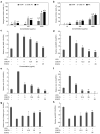Biological Activity and Component Analyses of Chamaecyparis obtusa Leaf Extract: Evaluation of Antiwrinkle and Cell Protection Effects in UVA-Irradiated Cells
- PMID: 37109713
- PMCID: PMC10146071
- DOI: 10.3390/medicina59040755
Biological Activity and Component Analyses of Chamaecyparis obtusa Leaf Extract: Evaluation of Antiwrinkle and Cell Protection Effects in UVA-Irradiated Cells
Abstract
Background and Objectives: Chamaecyparis obtusa (C. obtuse) extract has been used as a folk medicinal remedy in East Asian countries to alleviate inflammation and prevent allergies. Active oxygen causes skin aging and leads to skin cell and tissue damage. Extensive research has been conducted to control active oxygen generation to prevent skin aging. We evaluated the antioxidant activity and antiwrinkle effect of C. obtusa extract to determine its potential as a cosmetic material. Materials and Methods: The antioxidant activity of a 70% ethanol extract of C. obtusa (COE 70) and a water extract of C. obtusa (COW) was determined using 2,2-diphenyl-1-picrylhydrazy (DPPH) scavenging, 2,2'-azino-bis(3-ethylbenzothiazoline-6-sulfonic acid) (ABTS+) scavenging, superoxide dismutase-like activity, xanthine oxidase inhibition, and ferric-reducing antioxidant power assays. The effective concentration of the extracts was determined using the methyl thiazolyl tetrazolium assay to evaluate their toxicity. The effects of COE 70 on the production of matrix metalloproteinases (MMPs) and procollagen, and expression of activated cytokines, interleukin 6 (IL-6) and tumor necrosis factor α (TNF-α), in UVA-irradiated fibroblasts were determined using quantitative real-time PCR. Additionally, quercitrin, amentoflavone, hinokiflavone, and myricetin concentrations in COE 70 were determined using high-pressure high-performance liquid chromatography. Results: COE 70 had higher polyphenol and flavonoid concentrations than COW and exhibited an excellent antioxidant effect. COE 70 suppressed UVA-induced fibroblast death by 21.3% at 25 µg/mL. It also increased MMP-1, MMP-3, TNF-α, and IL-6 mRNA levels at 5-25 µg/mL compared with those in control UVA-irradiated fibroblasts. Moreover, mRNA levels of collagen type I and superoxide dismutase significantly increased, indicating the antiwrinkle and anti-inflammatory effects of the extract. Among the COE 70 components, quercitrin concentration was the highest; hence, quercitrin could be an active ingredient. Conclusions: COE 70 could be used as a natural antioxidant and antiwrinkle agent.
Keywords: Chamaecyparis obtusa; antioxidant; antiwrinkle; fibroblast; flavonoid; quercitrin.
Conflict of interest statement
The authors declare no conflict of interest.
Figures




Similar articles
-
The Precious Potential of the Sacred Tree Chamaecyparis obtusa (Siebold & Zucc.) Endl. as a Source of Secondary Metabolites with Broad Biological Applications.Int J Mol Sci. 2024 Feb 27;25(5):2723. doi: 10.3390/ijms25052723. Int J Mol Sci. 2024. PMID: 38473970 Free PMC article. Review.
-
Antioxidant activity and delayed aging effects of hot water extract from Chamaecyparis obtusa var. formosana leaves.J Agric Food Chem. 2014 May 7;62(18):4159-65. doi: 10.1021/jf500842v. Epub 2014 Apr 28. J Agric Food Chem. 2014. PMID: 24766147
-
The effects of Chamaecyparis obtusa essential oil on pain-related behavior and expression of pro-inflammatory cytokines in carrageenan-induced arthritis in rats.Biosci Biotechnol Biochem. 2016;80(1):203-9. doi: 10.1080/09168451.2015.1075864. Epub 2015 Aug 19. Biosci Biotechnol Biochem. 2016. PMID: 26581235
-
23-Hydroxytormentic acid protects human dermal fibroblasts by attenuating UVA-induced oxidative stress.Photodermatol Photoimmunol Photomed. 2017 Mar;33(2):92-100. doi: 10.1111/phpp.12294. Epub 2017 Feb 9. Photodermatol Photoimmunol Photomed. 2017. PMID: 28106292
-
Pharmacological anti-tumor effects of natural Chamaecyparis obtusa (siebold & zucc.) endl. Leaf extracts on breast cancer.J Ethnopharmacol. 2023 Sep 15;313:116598. doi: 10.1016/j.jep.2023.116598. Epub 2023 May 3. J Ethnopharmacol. 2023. PMID: 37146844
Cited by
-
The Precious Potential of the Sacred Tree Chamaecyparis obtusa (Siebold & Zucc.) Endl. as a Source of Secondary Metabolites with Broad Biological Applications.Int J Mol Sci. 2024 Feb 27;25(5):2723. doi: 10.3390/ijms25052723. Int J Mol Sci. 2024. PMID: 38473970 Free PMC article. Review.
-
Matrix Metalloproteinases on Skin Photoaging.J Cosmet Dermatol. 2024 Dec;23(12):3847-3862. doi: 10.1111/jocd.16558. Epub 2024 Sep 4. J Cosmet Dermatol. 2024. PMID: 39230065 Free PMC article. Review.
-
Anti-Inflammatory Effects of Chamaecyparis obtusa (Siebold & Zucc.) Endl. Leaf Extract Fermented by Ganoderma applanatum Mycelia.Pharmaceutics. 2024 Mar 5;16(3):365. doi: 10.3390/pharmaceutics16030365. Pharmaceutics. 2024. PMID: 38543259 Free PMC article.
References
MeSH terms
Substances
Grants and funding
LinkOut - more resources
Full Text Sources
Medical
Miscellaneous

